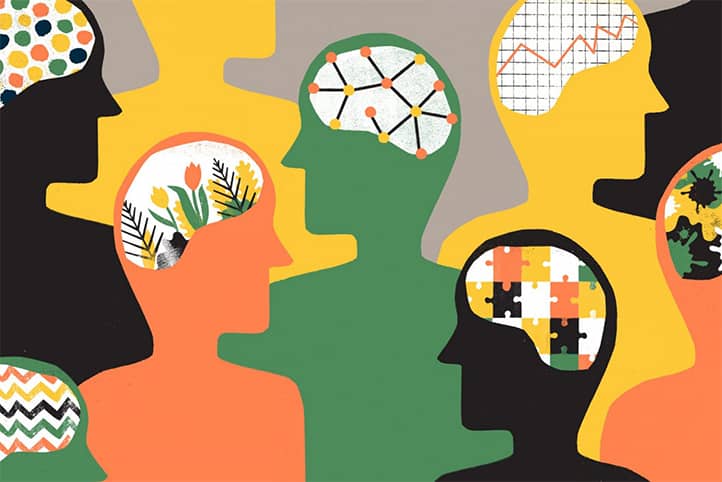Causal attribution is a fundamental process in social psychology that plays a key role in our understanding of the world and our interactions with others. This term refers to how people interpret the causes of events and behaviors—both their own and those of others.
Causal attribution is the process by which people try to explain the causes of events, behaviors, or outcomes. The word “causal” comes from the Latin “causa,” meaning “cause,” and “attribution” from the Latin “attributio,” meaning “assignment.” Thus, causal attribution literally means “assignment of causes.”
Understanding causal attribution is critically important for psychology and social sciences for several reasons:
- It affects our perception of the world and others around us.
- It influences our emotional reactions to events and the behavior of others.
- It determines our expectations regarding future events and behaviors.
- Causal attribution affects our own behavior and decision-making.
The study of causal attribution allows us to better understand how people interpret their social world and how these interpretations affect their thoughts, feelings, and actions.

The History of Causal Attribution Study
The human mind has always sought to grasp the reasons behind the events around us. This timeless quest for meaning and explanations laid the foundation for the scientific study of causal attribution. Like archaeologists excavating ancient civilizations, psychologists began to systematically investigate layers of human thought to understand how we assign causes to events and behavior.
The journey into the world of causal attribution began with simple observations of people’s everyday behavior. Scientists noticed that people constantly make assumptions about the causes of events, often without realizing it. These informal observations sparked the flame of scientific interest in attribution processes.
As psychology developed as a science, researchers began to create more rigorous methods for studying attributional processes. They designed experimental situations in which it was possible to observe how people draw conclusions about the causes of others’ behavior. These early experiments laid the groundwork for future theories and models of causal attribution.
Each new discovery in the field of causal attribution led to new questions. Researchers found that the attribution process is far more complex than initially thought. It depended on numerous factors: from the observer’s personality to the cultural context. This complexity became a challenge for scientists, prompting them to develop increasingly sophisticated theories and research methods.
Early Theories: The Contribution of Fritz Heider
The systematic study of causal attribution began in the mid-20th century. One of the pioneers in this field was Austrian psychologist Fritz Heider, often called the “father of attribution theory.”
In his book The Psychology of Interpersonal Relations (1958), Heider suggested that people act as “naive psychologists,” trying to understand the causes of others’ behavior. He argued that we seek predictability and control in our social world, and therefore attempt to explain behavior by attributing it either to internal factors (such as personality traits) or external factors (such as the situation or environment).
The Development of the Concept: Contributions of Harold Kelley and Bernard Weiner
After Heider’s foundational work, attribution theory was further developed by the work of other researchers, especially Harold Kelley and Bernard Weiner.
Harold Kelley expanded on Heider’s ideas by proposing his “covariation model” of attribution. This model describes how people use information about consistency, distinctiveness, and consensus to draw conclusions about the causes of behavior.
Bernard Weiner, in turn, focused on attributions in the context of achievements and failures. He developed the achievement attribution theory, which explains how people interpret the causes of their successes and failures and how these interpretations influence their motivation and future behavior.

Main Types of Causal Attribution
In the kaleidoscope of human thought, causal attribution acts as a prism through which we perceive the world. Just as light, when passing through a prism, splits into a spectrum of colors, so too does our perception of the causes of events and behavior split into different types of attributions.
Each type of attribution is a kind of lens through which we view what happens. Some lenses focus our attention on the internal qualities of people, while others on external circumstances. The choice of lens often happens automatically but has profound consequences for our understanding of the world and our interaction with it.
Imagine that the types of attributions are various tools in a detective’s toolkit. Sometimes the detective uses a magnifying glass to examine the smallest details of a suspect’s personality. Other times, he uses a wide-angle lens to see the big picture of the situation. In a similar way, we use different types of attributions to solve the mysteries of human behavior.
Understanding the main types of causal attribution is the key to unraveling the complexity of human thought. It not only allows us to better understand how we interpret the world but also to recognize the limitations and biases of our perception. This knowledge becomes a bridge to a deeper understanding of ourselves and others.
In the process of causal attribution, people usually assign the causes of events or behavior to one of two main types: internal (dispositional) or external (situational) factors.
Internal (Dispositional) Attribution
Internal attribution occurs when we attribute the cause of behavior or an event to internal characteristics of a person. These might include:
- personality traits
- abilities
- motives
- attitudes
- emotional states
For example, if a student receives a high grade on an exam, we might attribute this to their intelligence or diligence in studying.
External (Situational) Attribution
External attribution occurs when we attribute the cause of behavior or an event to environmental factors or the situation. These might include:
- social pressure
- rules and norms
- physical environment
- chance or luck
- actions of other people
Continuing the exam example, if we attribute the high grade to the test being easy or to luck, this would be an external attribution.
It is important to note that these two types of attribution are not mutually exclusive. People often consider both internal and external factors when explaining events or behavior.

Theories of Causal Attribution
Theories of causal attribution are like maps, helping us navigate the complex landscape of human thinking. Each theory highlights a particular aspect of the attribution process, just as different maps can show the topography, climate, or political boundaries of the same territory.
The development of causal attribution theories mirrors the evolution of scientific thought in other fields. Starting with simple models, researchers have gradually created increasingly complex and detailed theories. Each new theory builds on the foundation of previous ones, complementing and refining our understanding of attribution processes.
The diversity of causal attribution theories reflects the multifaceted nature of the process itself. Just as different artists might depict the same landscape differently, various theories offer unique perspectives on the attribution process. This multiplicity of views enriches our understanding and opens up new horizons for research.
Causal attribution theories do not exist in isolation. They interact with each other, with other areas of psychology, and with practical issues in the real world. This interaction generates new ideas and directions for research, continually expanding our knowledge of how people interpret the causes of events and behavior.
Over years of research, several key theories have been developed to explain the process of causal attribution. Let’s look at three of the most influential ones.
Jones and Davis’s Correspondent Inference Theory
Edward Jones and Keith Davis proposed the theory of correspondent inference in 1965. This theory focuses on how people draw conclusions about others’ intentions and dispositions based on their actions.
Key points of the theory:
- People try to determine whether the behavior was intentional or accidental.
- If the behavior seems intentional, people try to understand how much it corresponds to the person’s character.
- Unusual or unexpected behavior is more likely to lead to dispositional attribution.
The theory suggests that we make stronger dispositional inferences when:
- Behavior has low social desirability.
- Behavior has specific consequences.
- Behavior personally affects the observer.
Kelley’s Covariation Model
Harold Kelley developed the covariation model of attribution in 1967. This model describes how people use patterns in behavior to determine its causes.
Kelley suggested three key factors people consider in attribution:
- Consistency. How often does the person behave this way in similar situations?
- Distinctiveness. Does the person behave differently in other situations?
- Consensus. Do other people behave similarly in the same situation?
Based on the combination of these factors, people draw conclusions about the causes of behavior:
- High consistency + low distinctiveness + low consensus → internal attribution
- Low consistency + high distinctiveness + high consensus → external attribution
Weiner’s Achievement Attribution Theory
Bernard Weiner developed the achievement attribution theory, which focuses on how people explain the causes of their successes and failures.
Weiner proposed three main dimensions of causal attributions:
- Locus (internal vs. external).
- Stability (stable vs. unstable).
- Controllability (controllable vs. uncontrollable).
Based on these dimensions, Weiner identified four main reasons people typically attribute to their achievements:
- Abilities (internal, stable, uncontrollable).
- Effort (internal, unstable, controllable).
- Task difficulty (external, stable, uncontrollable).
- Luck (external, unstable, uncontrollable).
Weiner’s theory emphasizes that these attributions affect people’s emotional reactions and expectations for future outcomes, which in turn influence their motivation and behavior.

Errors and Biases in the Attribution Process
The human mind, despite its incredible capacity for analysis and understanding, is not immune to errors. In the process of causal attribution, these errors and biases stand out, like optical illusions distorting our perception of reality.
Attribution errors can be compared to funhouse mirrors that distort our interpretation of events and behavior—sometimes amusingly, sometimes dramatically. But unlike a funhouse, where we recognize distortions, in real life, we often don’t notice how skewed our perceptions can be.
Studying errors and biases in the attribution process is like a journey into the depths of human cognition. It reveals not only the limitations of our thinking but also the remarkable strategies our brains use to process information quickly in a complex, uncertain world.
Awareness of these errors and biases is the first step toward more objective and balanced thinking. Just as knowing about optical illusions helps us better understand how vision works, understanding attributional biases allows us to critically evaluate our judgments and interpretations.
Fundamental Attribution Error
The fundamental attribution error is one of the most studied phenomena in social psychology. It refers to the tendency to overestimate the influence of personal factors and underestimate the influence of situational factors when explaining other people’s behavior.
For example:
- If someone is late to a meeting, we might conclude that the person is irresponsible (a personal factor) without considering possible external circumstances, such as traffic (a situational factor).
Reasons for the fundamental attribution error:
- Limited information about the situation.
- Cognitive economy (simplifying information processing).
- Cultural factors (especially prominent in individualistic cultures).
Self-Serving Bias
The self-serving bias refers to the tendency to attribute positive outcomes to internal factors and negative outcomes to external factors.
Examples:
- We might attribute success on an exam to our abilities and hard work.
- Failure on the same exam might be explained by the test’s difficulty or poor health.
Functions of the self-serving bias:
- Maintaining self-esteem.
- Protecting against negative emotions.
- Motivating future achievements.
However, excessive self-serving bias can lead to unrealistic self-assessment and hinder learning from mistakes.
Actor-Observer Effect
The actor-observer effect describes the tendency of people to explain their own behavior through situational factors while attributing others’ behavior to personal factors.
Example:
- When we are rude to someone, we might explain it by stress or having a bad day (situational factor).
- When someone is rude to us, we tend to think they are impolite or aggressive (personal factor).
Reasons for the actor-observer effect:
- Differences in available information (we know more about our own situation than others’).
- Differences in focus of attention (we focus on the situation when acting ourselves, and on the person when observing others).
- Motivational factors (the desire to maintain a positive self-image).
Understanding these errors and biases is essential for developing a more objective and balanced approach to interpreting behavior and events. Awareness of these tendencies helps us make more accurate attributions and improve our social interactions.

The Influence of Culture on Causal Attribution
Culture is an invisible lens through which we view the world. It shapes our perception, thinking, and behavior, often without us realizing it. In the context of causal attribution, culture acts as a powerful filter, determining how we interpret the causes of events and actions.
Studying the influence of culture on causal attribution is a journey across the diverse landscape of human thinking. It reveals the amazing variety of ways in which people make sense of the world around them. This exploration not only enriches our understanding of attribution processes but also fosters intercultural dialogue and mutual understanding.
Cultural differences in attribution remind us that our understanding of causality is not universal or absolute. It is deeply rooted in our cultural context. Recognizing this fact opens doors to a deeper understanding of ourselves and others, fostering empathy and cultural competence in our increasingly globalized world.
Just as different languages may have unique words and expressions for describing the same phenomenon, different cultures may have their own unique ways of explaining the causes of events and behavior. The differences are especially noticeable between individualistic and collectivist cultures.
Individualistic Cultures
Individualistic cultures, common in many Western countries (e.g., the USA, the UK, Australia), have the following characteristics regarding causal attribution:
- Tendency toward internal attribution. People from individualistic cultures are more likely to explain behavior with personal factors.
- Emphasis on individual responsibility. Successes and failures are more often attributed to an individual’s qualities, efforts, or abilities.
- More pronounced fundamental attribution error. The tendency to overestimate personal factors and underestimate situational factors is more noticeable in individualistic cultures.
- Self-enhancing attributions. The tendency to attribute successes to internal factors and failures to external ones (self-serving bias) is more prominent in individualistic societies.
Collectivist Cultures
Collectivist cultures, more typical in many Asian, African, and Latin American countries, display other trends in causal attribution:
- Tendency toward external attribution. People from collectivist cultures are more likely to explain behavior with situational factors or group influence.
- Emphasis on group responsibility. Successes and failures are more often seen as the result of collective effort or circumstances.
- Less pronounced fundamental attribution error. The tendency to consider situational factors when explaining others’ behavior is more evident in collectivist cultures.
- Self-critical attributions. In some collectivist cultures (e.g., Japan), there is a tendency to attribute failures to internal factors and successes to external ones, which is the opposite of the self-serving bias.
The Impact of Cultural Differences on Social Interaction
Understanding cultural differences in causal attribution is essential for several reasons:
- Intercultural communication. Awareness of differences in attribution styles can help avoid misunderstandings and conflicts in intercultural interactions.
- Management and leadership. Leaders of international teams should consider cultural differences in interpreting success and failure to effectively motivate and evaluate employees.
- Education. Teachers working with multicultural audiences can adapt their teaching and assessment methods, considering differences in attribution styles.
- Psychotherapy. Psychologists and therapists should take cultural context into account when working with clients from diverse cultures, especially in analyzing their interpretations of life events.
- Marketing and advertising. Understanding cultural differences in causal attribution aids in developing more effective marketing strategies for different cultural groups.
It is important to note that although these differences exist at the level of cultural tendencies, there are always individual variations within each culture. Furthermore, in the era of globalization, the boundaries between cultural attribution styles are becoming less clear, especially in multicultural societies.

Application of Causal Attribution Theories
Causal attribution theories, born in the laboratories of psychologists, have not remained confined to academic institutions. Like seeds dispersed by the wind, these theories have found fertile ground in various fields of human activity. From clinical offices to courtrooms, from classrooms to corporate offices—wherever people seek to understand the causes of behavior and events, attribution theories find their application.
In the world of practical application, attribution theories become tools of transformation. They help therapists treat depression, marketers create persuasive advertising campaigns, managers motivate employees, and teachers inspire students. Just as knowledge of physical laws enables engineers to build bridges and skyscrapers, understanding the laws of attribution helps professionals create more effective social interactions and organizations.
The application of causal attribution theories is not merely the transfer of abstract concepts into the real world. It is a two-way process in which practice enriches theory, and theory enhances practice. Every new application of attribution theories in the real world generates new questions and ideas, stimulating further research and development in this fascinating field of psychology.
Attribution theories have found wide applications in various fields of psychology and related disciplines. Let’s consider some of the most significant applications.
In Clinical Psychology
- Diagnosis and Therapy of Depression:
- Martin Seligman’s theory of learned helplessness is based on the idea that depression can result from a specific attributional style.
- People prone to attributing negative events to stable, global, and internal causes are more vulnerable to depression.
- Cognitive-behavioral therapy often includes work to modify maladaptive attributional styles.
- Treatment of Anxiety Disorders:
- Understanding how clients interpret the causes of their anxiety can help in developing effective treatment strategies.
- Reattribution techniques are used to assist clients in reevaluating the causes of their symptoms.
- Work with Eating Disorders:
- Investigating attributions related to body image and eating helps in understanding and treating these disorders.
In Social Psychology
- Study of Intergroup Relations:
- Attribution theories help explain the formation and maintenance of stereotypes and prejudices.
- Studying how people explain the behavior of members of their own and other groups aids in understanding intergroup conflicts.
- Analysis of Prosocial Behavior:
- Attribution research helps explain why people do or do not help others in different situations.
- Study of Romantic Relationships:
- Attribution theories are applied to understand how partners interpret each other’s behavior and how this affects relationship satisfaction.
In Organizational Psychology
- Leadership and Management:
- Understanding attributional processes helps leaders better evaluate and motivate employees.
- Attribution theories are used to develop fairer performance appraisal systems.
- Organizational Behavior:
- Examining how employees explain the successes and failures of an organization helps in managing organizational change.
- Employee Motivation:
- Weiner’s attribution theory of achievement is applied to develop strategies for increasing employee motivation.
- Conflict Resolution:
- Understanding attributional processes aids in mediation and conflict resolution in the workplace.
In Educational Psychology
- Student Motivation:
- Attribution theories are used to understand and improve learning motivation.
- Teaching adaptive attributional styles helps students cope better with academic challenges.
- Teacher Training:
- Teachers are trained to recognize and influence student attributions to improve academic outcomes.
- Development of Educational Programs:
- Understanding attributional processes aids in creating more effective teaching and assessment methods.
In Legal Psychology
- Witness Testimony Analysis:
- Attribution theories help understand how witnesses interpret and remember events.
- Decision-Making by Jurors:
- Research on how jurors attribute responsibility and guilt is based on attribution theories.
In Marketing and Advertising
- Consumer Behavior Research:
- Attribution theories are applied to understand how consumers explain their choices of products and brands.
- Advertising Strategy Development:
- Understanding attributional processes helps create more persuasive advertising messages.
The use of causal attribution theories in various fields demonstrates their broad applicability and importance in understanding human behavior and thinking in diverse contexts.

Modern Research and Prospects
In an era of rapid technological progress, causal attribution research is entering an exciting new phase. Just as the invention of the microscope opened a world of microorganisms to scientists, modern technologies are providing attribution researchers with new dimensions of human thinking and behavior.
Contemporary causal attribution research can be compared to the exploration of a new planet. Every day, scientists discover new “continents” and “oceans” in the landscape of human cognition. They map neural networks involved in attribution processes, investigate the influence of social media on the formation of attributional styles, and explore the interaction of culture and biology in attribution processes.
As the field of causal attribution research continues to actively evolve, offering new research methods and opening new avenues for exploration, the future promises not only new scientific discoveries but also revolutionary practical applications. Let’s consider some current trends and prospects in this area.
New Methods for Studying Causal Attribution
- Neuroimaging:
- Using fMRI and other neuroimaging techniques to study brain mechanisms underlying attribution processes.
- These methods help to understand how the brain processes information during causal attribution.
- Big Data Analysis:
- Employing machine learning and big data analysis to examine attribution patterns in social media and online communication.
- This approach enables studying attributions in natural environments and on large samples.
- Virtual Reality:
- Creating controlled social situations in virtual reality to study attributional processes in more realistic but controlled conditions.
- Ecological Momentary Assessment:
- Using mobile devices to collect data on attributions in real-time in people’s daily lives.
Current Research Directions
- Cultural Neuroscience of Attribution:
- Studying how cultural differences in attributional processes are reflected at the brain activity level.
- This direction combines cultural psychology and neuroscience for a deeper understanding of culture’s influence on cognitive processes.
- Attribution in Social Media:
- Investigating how people interpret and attribute causes to events and behaviors in online environments.
- Studying the influence of social media algorithms on users’ attributional processes.
- Attribution and Artificial Intelligence:
- Developing machine learning models capable of imitating human attributional processes.
- Exploring how people attribute causes to actions performed by artificial intelligence.
- Attribution in the Context of Global Challenges:
- Examining attributional processes regarding issues like climate change, pandemics, and economic crises.
- This research can help develop more effective communication strategies and solutions for global challenges.
- Development of Attributional Processes:
- Studying how attributional styles form in childhood and change throughout life.
- Developing interventions to foster adaptive attributional styles in children and adolescents.
- Attribution and Mental Health:
- Further exploring the role of attributional processes in the development and maintenance of various mental disorders.
- Developing new therapeutic approaches based on modifying attributional styles.
- Intergroup Attributions in a Polarized Society:
- Investigating how people explain the actions and motives of members of opposing political or social groups in a polarized society.
- Attribution and Decision-Making:
- Studying the influence of attributional processes on decision-making in various contexts, from personal finance to global politics.
These new research directions open exciting prospects for further development of causal attribution theory and its practical application in various areas of life.

Conclusion
Causal attribution, this fundamental process of human cognition, continues to captivate and intrigue researchers with its complexity and significance. From early theoretical constructs to modern neuroscience research, the study of causal attribution has traversed a long and fascinating path, revealing ever-new facets of this remarkable phenomenon.
For decades, scientists have developed various theories and models to explain how people attribute causes to events and behavior. These theories, from Fritz Heider’s early work to modern integrative approaches, have not only deepened our understanding of cognitive processes but have also found broad practical application in various fields of life.
Research has shown that the attribution process is not free from errors and biases. Fundamental attribution error, egocentric bias, and other phenomena demonstrate how complex and ambiguous our perception of causality can be. Awareness of these limitations opens the way to more critical and reflective thinking, allowing us to better understand ourselves and others.
The cultural context, as it turns out, plays a huge role in shaping attributional styles. Differences between individualistic and collectivistic cultures in approaches to explaining the causes of events and behavior highlight the diversity of human thought and the importance of intercultural understanding in our globalized world.
The application of causal attribution theories in various fields—from clinical psychology to organizational management—demonstrates their practical relevance and potential for solving real-world problems. These theories have become indispensable tools for professionals working with people in diverse contexts.
Modern research, using advanced technologies and methods, opens new horizons in understanding attribution processes. From the neurobiological basis to the impact of digital technology on the formation of attributional styles, each new discovery expands our knowledge and generates new questions.
In conclusion, the study of causal attribution remains one of the most exciting directions in psychology. It not only reveals fundamental aspects of human thought but also provides valuable tools for understanding and improving human interactions.




